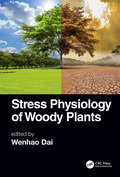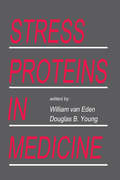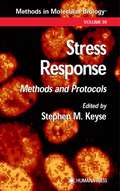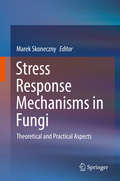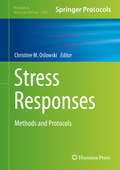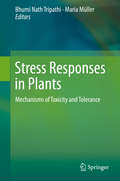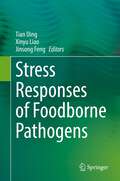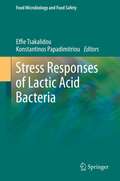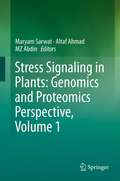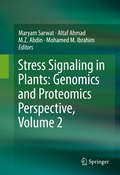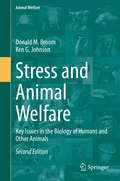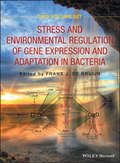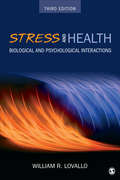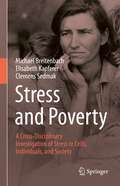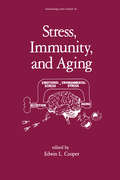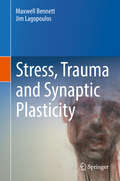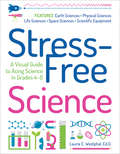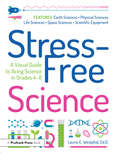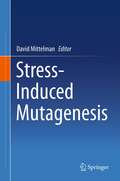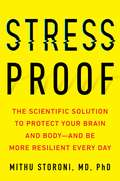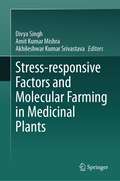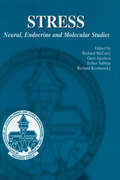- Table View
- List View
Stress Physiology of Woody Plants
by Wenhao DaiThis book addresses the importance woody plants have in agriculture, forestry, and the environment and how various stresses affect their performance. It reviews physiological and molecular responses of woody plants to major environmental stresses and focuses on the mechanisms involved in imparting resistance to stress. Chapters cover basics of plant physiology including plant structure and plant growth, photosynthesis, respiration, plant growth regulation, abiotic and biotic plant stresses including drought, water logging, nutrient deficiency, salinity, chilling, freezing, heat, oxidative stress, and heavy metal toxicity.
Stress Proteins in Medicine
by Willem Van EdenProvides a thorough overview of current knowledge of stress proteins in both normal and disease physiology and evaluates the potential for developing novel diagnostic, prophylactic, and therapeutic approaches to control human disease based on the latest stress-protein research.
Stress Response
by Stephen M. KeyseIt is now understood that the response of mammalian cells to a wide variety of potentially toxic agents may be intimately linked with many human diseases, including rheumatoid arthritis, ischemia, fever, infection, and cancer. In Stress Response: Methods and Protocols, Stephen Keyse has assembled a diverse collection of readily reproducible methods devoted to the study of these varied and powerful responses. Written by leading researchers expert in the techniques they describe, these detailed methods cover the detection and assay of stress-induced damage, the activation of a wide range of signal transduction pathways by cellular stress, stress-induced gene expression, and stress protein function. To ensure experimental success, step-by-step guidance is provided for each method, along with details of reagents, equipment, and other requirements. The methods include both well-established techniques and new technologies at the leading edge of research. Wide ranging and highly practical, Stress Response: Methods and Protocols provides a gold-standard bench manual for today's basic and clinical scientists working to understand how cells and tissues respond during physiological stress and in human disease.
Stress Response Mechanisms in Fungi: Theoretical and Practical Aspects
by Marek SkonecznyThis book covers both the molecular basics of fungal stress response strategies as well as biotechnological applications thereof. The complex regulatory mechanisms of stress response pathways are presented in a concise and well-readable manner. Also, light will be shed on the interconnection of pathways responding to different types of stress. Profound knowledge of stress responses in yeast and filamentous fungi is crucial for further optimization of industrial processes. Applications are manifold, for example in fungicide development, for improving the resistance of crop plants to fungal pathogens, but also in medicine to help curing fungal infections. The book targets researchers from academia and industry, as well as graduate students interested in microbiology, mycology and biomedicine.
Stress Responses
by Christine M. OslowskiThis volume focuses on detecting different cellular stresses, measuring pathological consequences within the cell, and investigating the role of cellular stresses in select diseases. In addition, this book reviews the crosstalk between different stress pathways, stress responses during ageing, and targeting stress for regenerative medicine. Written in the highly successful Methods of Molecular Biology series format, chapters include introductions to their respective topics, lists of the necessary materials and reagents, step-by-step, readily reproducible laboratory protocols, and key tips on troubleshooting and avoiding known pitfalls. Authoritative and instructive, Stress Responses: Methods and Protocols seeks to aid scientists to further study multiple stress pathways and outcomes triggered by such stresses. In depth knowledge of cellular stress will eventually lead to the development of novel therapeutics to prevent or treat related diseases.
Stress Responses in Plants
by Bhumi Nath Tripathi Maria MüllerThis collection discusses the variety of specific molecular reactions by means of which plants respond to physiological and toxic stress conditions. It focuses on the characterization of the molecular mechanisms that underlie the induction of toxicity and the triggered responses and resistances. The nine chapters, all written by prominent researchers, examine heavy metal toxicity, aluminum toxicity, arsenic toxicity, salt toxicity, drought stress, light stress, temperature stress, flood stress and UV-B stress. In addition, information on the fundamentals of stress responses and resistance mechanisms is provided. The book addresses researchers and students working in the fields of plant physiology and biochemistry.
Stress Responses of Foodborne Pathogens
by Tian Ding Xinyu Liao Jinsong FengFood-borne bacterial pathogens encounter a number of stressors during food processing and preservation. More and more pathogens are able to adapt their physiological properties and/or genetic expression to survive these stressors and pose a risk to food safety and public health. This book provides the reader with a comprehensive overview of common food processing-associated stressors (e.g., heat, cold, acid, osmosis, and oxidation) and deals with the molecular basis of the respective bacterial stress response mechanisms (e.g., viable but nonculturable state, biofilm formation, sporulation, and cross-protection response). Additionally, various chapters cover the response mechanisms of foodborne pathogens to emerging nonthermal sterilisation technologies such as ultrasound, high-pressure processing, pulsed electric fields, ultraviolet light, irradiation and phytochemicals. Through this book we also learn about future prospects for the efficient control of stress adaption in foodborne pathogens to ensure maximum consumer safety. This book offers a valuable resource for researchers, graduate students, food process engineers and product developers in the fields of food science and microbiology.
Stress Responses of Lactic Acid Bacteria
by Konstantinos Papadimitriou Effie TsakalidouBeginning with the basics of lactic acid bacteria and stress response, then working into specific fields of research and current developments, Stress Responses of Lactic Acid Bacteria will serve as an essential guidebook to researchers in the field, industry professionals, and advanced students in the area. The exploration of stress responses in lactic acid bacteria began in the early 90s and revealed the differences that exist between LAB and the classical model microorganisms. A considerable amount of work has been performed on the main genera / species of LAB regarding the genes implicated and their actual role and regulation, and the mechanisms of stress resistance have also been elucidated. Recent genome and transcriptome analyses complement the proteome and genetic information available today and shed a new light on the perception of and the responses to stress by lactic acid bacteria.
Stress Signaling in Plants: Genomics and Proteomics Perspective, Volume 1
by Maryam Sarwat Altaf Ahmad Mz AbdinPlant diseases, extreme weather caused by climate change, drought and an increase in metals in soil are amongst the major limiting factors of crop production worldwide. They devastate not only food supply but also the economy of a nation. Keeping in view of the global food scarcity, there is, an urgent need to develop crop plants with increased stress tolerance so as to meet the global food demands and to preserve the quality of our planet. In order to do this, it is necessary to understand how plants react and adapt to stress from the genomic and proteomic perspective. Plants adapt to stress conditions by activation of cascades of molecular mechanisms, which result in alterations in gene expression and synthesis of protective proteins/compounds. From the perception of the stimulus to transduction of the signal, followed by an appropriate response, the plants employ a complex network of primary and secondary messenger molecules. Cell signaling is the component of a complex system of communication that directs basic cellular activities and synchronizes cell actions. Cells exercise a large number of noticeably distinct signaling pathways to regulate their activity. In order to contend with different environmental adversities plants have developed a series of mechanisms at the physiological, cellular and molecular level. This two volume set takes an in-depth look at the Stress Signaling in Plants from a uniquely genomic and proteomics perspective. Stress Signaling in Plants offers a comprehensive treatise on the Chapter, covering all of the signaling pathways and mechanisms that have been researched so far. Each chapter provides in-depth explanation of what we currently know of a particular aspect of stress signaling and where we are headed. All authors have currently agreed and abstracts have been complied for the first volume, due out midway through 2012. We aim to have the second volume out at the beginning of 2013.
Stress Signaling in Plants: Genomics and Proteomics Perspective, Volume 2
by Maryam Sarwat Altaf Ahmad M. Z. Abdin Mohamed M. IbrahimThis two-volume set takes an in-depth look at stress signaling in plants from a uniquely genomic and proteomic perspective and offers a comprehensive treatise that covers all of the signaling pathways and mechanisms that have been researched so far. Currently, plant diseases, extreme weather caused by climate change, drought and an increase in metals in soil are amongst the major limiting factors of crop production worldwide. They devastate not only the food supply but also the economy of a nation. With global food scarcity in mind, there is an urgent need to develop crop plants with increased stress tolerance so as to meet the global food demands and to preserve the quality of our planet. In order to do this, it is necessary to understand how plants react and adapt to stress from the genomic and proteomic perspective. Plants adapt to stress conditions by activating cascades of molecular mechanisms, which result in alterations in gene expression and synthesis of protective proteins. From the perception of the stimulus to the transduction of the signal, followed by an appropriate cellular response, the plants employ a complex network of primary and secondary messenger molecules. Cells exercise a large number of noticeably distinct signaling pathways to regulate their activity. In order to contend with different environmental adversities, plants have developed a series of mechanisms at the physiological, cellular and molecular levels that respond to stress. Each chapter in this volume provides an in-depth explanation of what we currently know of a particular aspect of stress signaling and where we are heading. Together with the highly successful first volume, Stress Signaling in Plants: Genomics and Proteomics Perspective, Volume 2 covers an important aspect of plant biology for both students and seasoned researchers.
Stress and Animal Welfare: Key Issues in the Biology of Humans and Other Animals (Animal Welfare #19)
by Donald M. Broom Ken G. JohnsonThis is the Second Edition of a well-received book that reflects a fresh, integrated coverage of the concepts and scientific measurement of stress and welfare of animals including humans. This book explains the basic biological principles of coping with many forms of adversity. The major part of this work is devoted to explaining scientifically usable concepts in stress and welfare. A wide range of welfare indicators are highlighted in detail with examples being drawn from man and other species. The necessity for combining information from disciplines is emphasized with a one-health, one-welfare approach. This information forms the basis for a synthesis of new ideas. Among the issues covered are:- How brain and body systems regulate using feelings, physiological responses, behaviour and responses to pathology- Limits to adaptation- Assessing positive and negative welfare during both short-term and long-term situations- Ethical problems and suggested solutionsA proper assessment of animal welfare is essential to take informed decisions about what is morally acceptable in terms of practice and in the development of a more effective legislation. This work encapsulates a very wide body of literature on scientific aspects of animal welfare and will thus prove a valuable asset for animal welfare scientists, psychologists, students and teachers of all forms of biology, behaviour, medicine, veterinary medicine and animal usage.
Stress and Environmental Regulation of Gene Expression and Adaptation in Bacteria, 2 Volume Set
by Frans J. de BruijnBacteria in various habitats are subject to continuously changing environmental conditions, such as nutrient deprivation, heat and cold stress, UV radiation, oxidative stress, dessication, acid stress, nitrosative stress, cell envelope stress, heavy metal exposure, osmotic stress, and others. In order to survive, they have to respond to these conditions by adapting their physiology through sometimes drastic changes in gene expression. In addition they may adapt by changing their morphology, forming biofilms, fruiting bodies or spores, filaments, Viable But Not Culturable (VBNC) cells or moving away from stress compounds via chemotaxis. Changes in gene expression constitute the main component of the bacterial response to stress and environmental changes, and involve a myriad of different mechanisms, including (alternative) sigma factors, bi- or tri-component regulatory systems, small non-coding RNA's, chaperones, CHRIS-Cas systems, DNA repair, toxin-antitoxin systems, the stringent response, efflux pumps, alarmones, and modulation of the cell envelope or membranes, to name a few. Many regulatory elements are conserved in different bacteria; however there are endless variations on the theme and novel elements of gene regulation in bacteria inhabiting particular environments are constantly being discovered. Especially in (pathogenic) bacteria colonizing the human body a plethora of bacterial responses to innate stresses such as pH, reactive nitrogen and oxygen species and antibiotic stress are being described. An attempt is made to not only cover model systems but give a broad overview of the stress-responsive regulatory systems in a variety of bacteria, including medically important bacteria, where elucidation of certain aspects of these systems could lead to treatment strategies of the pathogens. Many of the regulatory systems being uncovered are specific, but there is also considerable "cross-talk" between different circuits. Stress and Environmental Regulation of Gene Expression and Adaptation in Bacteria is a comprehensive two-volume work bringing together both review and original research articles on key topics in stress and environmental control of gene expression in bacteria. Volume One contains key overview chapters, as well as content on one/two/three component regulatory systems and stress responses, sigma factors and stress responses, small non-coding RNAs and stress responses, toxin-antitoxin systems and stress responses, stringent response to stress, responses to UV irradiation, SOS and double stranded systems repair systems and stress, adaptation to both oxidative and osmotic stress, and desiccation tolerance and drought stress. Volume Two covers heat shock responses, chaperonins and stress, cold shock responses, adaptation to acid stress, nitrosative stress, and envelope stress, as well as iron homeostasis, metal resistance, quorum sensing, chemotaxis and biofilm formation, and viable but not culturable (VBNC) cells.Covering the full breadth of current stress and environmental control of gene expression studies and expanding it towards future advances in the field, these two volumes are a one-stop reference for (non) medical molecular geneticists interested in gene regulation under stress.
Stress and Health: Biological and Psychological Interactions (Behavioral Medicine And Health Psychology Ser.)
by William R. LovalloStress and Health: Biological and Psychological Interactions is a brief and accessible examination of psychological stress and its psychophysiological relationships with cognition, emotions, brain functions, and the peripheral mechanisms by which the body is regulated. Updated throughout, the Third Edition covers two new and significant areas of emerging research: how our early life experiences alter key stress responsive systems at the level of gene expression; and what large, normal, and small stress responses may mean for our overall health and well-being.
Stress and Health: Biological and Psychological Interactions (Behavioral Medicine And Health Psychology Ser.)
by William R. LovalloStress and Health: Biological and Psychological Interactions is a brief and accessible examination of psychological stress and its psychophysiological relationships with cognition, emotions, brain functions, and the peripheral mechanisms by which the body is regulated. Updated throughout, the Third Edition covers two new and significant areas of emerging research: how our early life experiences alter key stress responsive systems at the level of gene expression; and what large, normal, and small stress responses may mean for our overall health and well-being.
Stress and Poverty: A Cross-Disciplinary Investigation of Stress in Cells, Individuals, and Society
by Clemens Sedmak Michael Breitenbach Elisabeth KapfererThe word stress is everywhere and highly overused. Everyone is stressed, it seems, all the time. Looking into the meaning of stress in the natural science and the humanities, this book explores cellular stress as cause of and in correlation with what humans experience as stress. When do we psychologically feel stress and when do we show physiological evidence of stress in our brain? Stress is a deviation from what feels normal and healthy. It can be created by social or economic factors and become chronic, which has substantial impacts on the individual and society as a whole. Focusing on poverty as one chronic inducer of stress, this book explores how the lack of pressure-free time, the hardships and unpredictability of everyday life and a general lack of protection lead to destructive toxic stress. This pressure affects cognitive and social functioning, brain development during childhood and may also result in premature aging. How can the sciences inform our understanding of and our response to stress? What can be done about toxic stress both on a personal level and in terms of structures and policies? The book is written for anyone interested in stress, its causes and consequences, and its relationship to poverty.
Stress and Strain Engineering at Nanoscale in Semiconductor Devices
by Chinmay K. MaitiAnticipating a limit to the continuous miniaturization (More-Moore), intense research efforts are being made to co-integrate various functionalities (More-than-Moore) in a single chip. Currently, strain engineering is the main technique used to enhance the performance of advanced semiconductor devices. Written from an engineering applications standpoint, this book encompasses broad areas of semiconductor devices involving the design, simulation, and analysis of Si, heterostructure silicongermanium (SiGe), and III-N compound semiconductor devices. The book provides the background and physical insight needed to understand the new and future developments in the technology CAD (TCAD) design at the nanoscale. Features Covers stressstrain engineering in semiconductor devices, such as FinFETs and III-V Nitride-based devices Includes comprehensive mobility model for strained substrates in global and local strain techniques and their implementation in device simulations Explains the development of strain/stress relationships and their effects on the band structures of strained substrates Uses design of experiments to find the optimum process conditions Illustrates the use of TCAD for modeling strain-engineered FinFETs for DC and AC performance predictions This book is for graduate students and researchers studying solid-state devices and materials, microelectronics, systems and controls, power electronics, nanomaterials, and electronic materials and devices.
Stress und Armut: Eine interdisziplinäre Untersuchung von Stress in Zellen, Individuen und Gesellschaft
by Clemens Sedmak Michael Breitenbach Elisabeth KapfererDas Wort Stress ist allgegenwärtig und ist ein Modewort geworden. Jeder ist gestresst, so scheint es, und das fortwährend. Dieses Buch befasst sich mit der Bedeutung von Stress in den Natur- und Geisteswissenschaften und untersucht zellulären Stress als Ursache für Stress und im Zusammenhang mit dem, was Menschen als Stress erleben. Wann empfinden wir in psychologischem Sinn Stress und wann zeigen wir physiologische Anzeichen von Stress in unserem Gehirn?Stress ist eine Abweichung von dem, was sich „normal“ und gesund anfühlt. Er kann durch soziale oder ökonomische Faktoren ausgelöst werden und kann chronisch werden, was erhebliche Auswirkungen auf den einzelnen Menschen und auf die Gesellschaft als Ganzes hat. Dieses Buch konzentriert sich auf Armut als eine chronische Ursache von Stress und untersucht, wie der Mangel an druckfreier Zeit, die Entbehrungen und die Unvorhersehbarkeit des Alltags sowie ein allgemeiner Mangel an Schutz zu destruktivem toxischem Stress führen. Dieser permanente Druck beeinträchtigt die kognitiven und sozialen Funktionen, die Gehirnentwicklung in der Kindheit und kann auch zu vorzeitiger Alterung führen. Was können die Wissenschaften für unser Verständnis von und unsere Reaktion auf Stress leisten? Was kann gegen toxischen Stress getan werden, sowohl auf persönlicher Ebene als auch in Bezug auf Strukturen und politische Maßnahmen?Das Buch richtet sich an alle, die sich für Stress, seine Ursachen und Folgen sowie für den Zusammenhang von Stress und Armut interessieren.
Stress, Immunity, and Aging
by E. L. CooperThis book contains two personal reminiscences of historical importance to research on stress and infectious disease. It deals with perspectives on immunity, aging, and disease and the prospects for immunorestoration in the treatment of immunodeficiency arising from aging and stress.
Stress, Trauma and Synaptic Plasticity
by Maxwell Bennett Jim LagopoulosThis book presents the latest state of knowledge on grey matter changes in the brain following stress and trauma. Where do these changes take place and what are the underlying molecular mechanisms? These questions are addressed in several sections, providing detailed insights into the cellular and molecular alterations that occur in the brain after stress and trauma. <p><p> The changes to the grey matter in certain areas of the brain are similar in stressed humans and animals, with the most likely basis for these changes being the degeneration of synaptic connections. In the book’s first sections the reader will learn about the core network of synaptic connections that are affected by stress and trauma disorders. These synaptic connections are modulated by dopamine, serotonin and Brain Derived Neurotrophic Factor (BDNF). In subsequent chapters, the NMDA-receptor mediated plasticity of these synapses is discussed, with particular attention given to how glucocorticoids can interfere with the function of BDNF and thereby affect the synapse’s physical stability. Furthermore, the reader will learn about the importance of the genetics of the glucocorticoid gene and the epigenetic control of BDNF in connection with synaptic plasticity. The authors conclude by integrating the observations summarized in the previous sections so as to present plausible hypotheses regarding the identity of the networks, synapses and molecular pathways that support fear and extinction. <p> Providing an up-to-date overview of the mechanisms of synaptic plasticity and physiological changes in the stressed and traumatized brain, this book will appeal to researchers, clinicians and students in the neurosciences.
Stress-Free Science: A Visual Guide to Acing Science in Grades 4-8
by Laurie E. WestphalEquipped with the #1 guide to help kids (and their parents) with science homework, students will be able to quickly find the definitions and illustrated examples that will enable them to solve many of the science challenges they face. Covering everything from "acceleration" to "zygote," Stress-Free Science:Is perfect for both kids and their parents looking for help with science homework and the tools to ace the class!Provides students in grades 4–8 with hundreds of science terms and kid-friendly definitions, full-color illustrations, and examples.Covers subjects like physical sciences, Earth sciences, life sciences, basic science equipment, and measurement and units.Helps students complete science tasks with confidence.Will help with any science assignment, project, or experiment.This well-organized and easy-to-follow quick reference guide includes illustrated, concise explanations of the most common terms used in general science classes. Packed with strategies to help students get better grades and master science concepts without any headaches, this science study guide also includes a handy reference section, complete with commonly used formulas, measurement conversions, charts detailing household chemicals and acids and bases, instructions for using science equipment safely, tips on following the scientific process, and information on graphing results and data.
Stress-Free Science: A Visual Guide to Acing Science in Grades 4-8
by Laurie E. WestphalEquipped with the #1 guide to help kids (and their parents) with science homework, students will be able to quickly find the definitions and illustrated examples that will enable them to solve many of the science challenges they face. Covering everything from "acceleration" to "zygote," Stress-Free Science: Is perfect for both kids and their parents looking for help with science homework and the tools to ace the class!Provides students in grades 4-8 with hundreds of science terms and kid-friendly definitions, full-color illustrations, and examples.Covers subjects like physical sciences, Earth sciences, life sciences, basic science equipment, and measurement and units.Helps students complete science tasks with confidence.Will help with any science assignment, project, or experiment.
Stress-Induced Mutagenesis
by David MittelmanThe discovery of stress-induced mutagenesis has changed ideas about mutation and evolution, and revealed mutagenic programs that differ from standard spontaneous mutagenesis in rapidly proliferating cells. The stress-induced mutations occur during growth-limiting stress, and can include adaptive mutations that allow growth in the otherwise growth-limiting environment. The stress responses increase mutagenesis specifically when cells are maladapted to their environments, i.e. are stressed, potentially accelerating evolution then. The mutation mechanism also includes temporary suspension of post-synthesis mismatch repair, resembling mutagenesis characteristic of some cancers. Stress-induced mutation mechanisms may provide important models for genome instability underlying some cancers and genetic diseases, resistance to chemotherapeutic and antibiotic drugs, pathogenicity of microbes, and many other important evolutionary processes. This book covers pathways of stress-induced mutagenesis in all systems. The principle focus is mammalian systems, but much of what is known of these pathways comes from non-mammalian systems.
Stress-Proof: The Scientific Solution to Protect Your Brain and Body--and Be More Resilient Every Day
by Mithu StoroniDiscover simple, science-based strategies for beating stress at its own game When’s the best time to exercise – and how much is too much? Which foods fortify the brain, and which do the opposite? How can we use music, movement, and motivation to boost our rational brain and keep our cool no matter what life throws our way? Short bursts of stress are an inevitable part of modern life. But how much is too much? Research is uncovering the delicate balance that can turn a brief stressful episode into systemic overload, eventually leading to inflammation, anxiety, depression, and other chronic health issues.This practical and groundbreaking guide reveals seven paths to fighting the effects of stress--to strengthen our natural defenses so that our minds remain sharp, and our bodies resilient, no matter what life throws at us.Each chapter examines a common stress agent—including inflammation, an out-of-sync body clock, cortisol levels, and emotional triggers—and presents simple ways to minimize its harmful effects with changes in diet, exercise, and other daily habits—including surprising hacks involving music, eye movements, body temperature, and more. Translating cutting-edge scientific findings into clear and simple advice, Stress-Proof is the ultimate user’s guide for body, mind and well-being.
Stress-responsive Factors and Molecular Farming in Medicinal Plants
by Amit Kumar Mishra Divya Singh Akhileshwar Kumar SrivastavaThis contributed volume brings out a comprehensive collection of changes from cellular to molecular levels in medicinal plants under extreme environments. The focus of this book is to address the molecular changes in medicinal plants under different abiotic stresses. Medicinal plants are regarded as rich resources of components that can be used for drug development in the pharmaceutical industry. A few medicinal plants are considered vital sources of nutrients and solicited for their therapeutic properties. Therefore, it is essential to understand medicinal plants' interaction under abiotic stresses as compounds obtained from these plants play an important role in human health. This book is of interest to students, teachers, researchers, scientists, medicinal plant experts, and policymakers. Also, the book provides study material for undergraduate and graduate students of botany, environmental sciences, medicinal and aromatic plants, biochemistry, and biotechnology. National and international scientists working in the area of medicinal plants, drug development, and policymakers will also find this a useful read
Stress: Neural, Endocrine and Molecular Studies
by Richard McCarty Greti Aguilera Esther L. Sabban Richard KvetňanskýDistilling information from the Seventh Symposium on Catecholamines and other Neurotransmitters in Stress held in the Slovak Republic, Stress: Neural, Endocrine and Molecular Studies presents the results of current research into stress focusing on catecholamines and other neurotransmitter molecules. Topics covered include peripheral influences on the stress response, central influences on the stress response, molecular regulation during stress, and more. This text is suitable for graduates and researchers in the disciplines of neuroscience, endocrinology, medicine, immunology, cell and molecular biology, biochemistry, pharmacology, and stress research.
